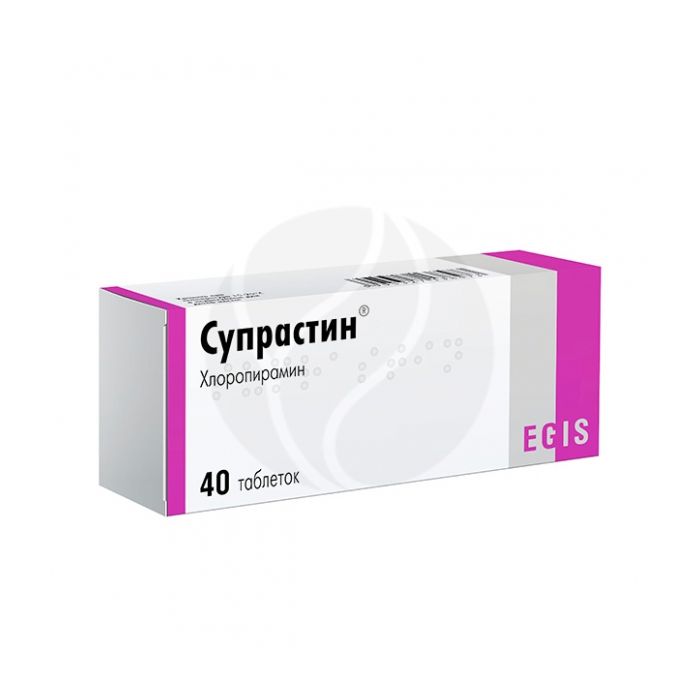Suprastin tablets 25mg, No. 40
Expiration Date: 05/2027
Russian Pharmacy name:
Супрастин таблетки 25мг, №40
hives;
serum sickness;
seasonal and perennial allergic rhinitis;
conjunctivitis;
contact dermatitis;
itchy skin;
acute and chronic eczema;
atopic dermatitis;
food and drug allergies;
allergic reactions to insect bites;
angioedema (angioedema) - as an aid.
Pills
Inside, during meals, without chewing and drinking plenty of water.
Adults: appoint 1 table. 3-4 times a day (75-100 mg / day).
Children: at the age of 3 to 6 years - 1/2 table. 2 times a day; from 6 to 14 years old - 1/2 tab. (12.5 mg) 2-3 times a day.
The dose can be gradually increased in the absence of side effects in the patient, but the maximum dose should never exceed 2 mg / kg.
The duration of the course of treatment depends on the symptoms of the disease, its duration and course.
Special patient groups
Elderly, emaciated patients. The use of the drug SuprastinЃ requires special care, because in these patients, antihistamines are more likely to cause side effects (dizziness, drowsiness).
Patients with impaired liver function. A dose reduction may be required due to a decrease in the metabolism of the active component of the drug in liver diseases.
Patients with impaired renal function. It may be necessary to change the regimen of taking the drug and reduce the dose due to the fact that the active component is mainly excreted through the kidneys.
Injection:
In / m, in / in (used only in acute severe cases under the supervision of a doctor!)
Adults: the recommended daily dose is 1-2 ml (1-2 amp.) IM.
Children: recommended initial doses - at the age of 1 to 12 months - 0.25 ml (1/4 amp.) IM; from 1 to 6 years old - 0.5 ml (1/2 amp.) IM; from 6 to 14 years old - 0.5-1 ml (1 / 2-1 amp.) IM.
The dose can be increased carefully depending on the patient's response and the side effects observed. However, the dose should never exceed 2 mg / kg. In severe allergies, treatment should be started with a slow, slow intravenous injection, followed by intramuscular injection or oral administration.
Special patient groups (general recommendations for both forms)
Elderly, emaciated patients: the use of the drug SuprastinЃ requires special care, because in these patients, antihistamines are more likely to cause side effects (dizziness, drowsiness).
Patients with impaired liver function: a dose reduction may be required due to a decrease in the metabolism of the active component of the drug in liver diseases.
Patients with impaired renal function: it may be necessary to change the regimen of the drug and reduce the dose due to the fact that the active component is mainly excreted through the kidneys.
| Pills | 1 tab. |
| active substance: | |
| chloropyramine hydrochloride | 25 mg |
| excipients: stearic acid - 3 mg; gelatin - 4 mg; sodium carboxymethyl starch (type A) - 6 mg; talc - 6 mg; potato starch - 40 mg; lactose monohydrate - 116 mg |
| Solution for intravenous and intramuscular administration | 1 ml |
| active substance: | |
| chloropyramine hydrochloride | 20 mg |
| excipients: water for injection - up to 1 ml |
hypersensitivity to drug components;
acute attack of bronchial asthma;
children under 3 years of age (for this dosage form);
lactase deficiency, lactose intolerance, glucose / galactose malabsorption (since the tablet contains 116 mg of lactose monohydrate);
pregnancy;
lactation period.
With care: angle-closure glaucoma; retention of urine; hyperplasia of the prostate; impaired liver and / or kidney function; cardiovascular diseases; elderly patients.
Pharmacological action
Suprastin is an anti-allergic drug.
Indications
Urticaria, serum sickness, seasonal and perennial allergic rhinitis, conjunctivitis, contact dermatitis, pruritus, acute and chronic eczema, atopic dermatitis, food and drug allergies, allergic reactions to insect bites;
Contraindications
Acute attack of bronchial asthma, pregnancy, lactation, children under 3 years of age, lactase deficiency, lactose intolerance, glucose-galactose malabsorption syndrome, hypersensitivity to the drug components.
The drug should be used with caution in angle-closure glaucoma, in patients with urinary retention, prostatic hyperplasia, in liver and / or kidney dysfunctions, cardiovascular diseases, in elderly patients.
Method of administration and dosage
Tablets should be taken orally with meals, without chewing and drinking plenty of water.
Adults are prescribed 25 mg (1 tab.) 3-4 times / day (75-100 mg / day).
Children aged 3 to 6 years are prescribed 1/2 tab. (12.5 mg) 2 times / day; children aged 6 to 14 years old - 1/2 tab. (12.5 mg) 2-3 times / day.
The dose can be gradually increased in the absence of side effects in the patient, but the maximum dose should not exceed 2 mg / kg body weight.
The duration of the course of treatment depends on the symptoms of the disease, its duration and course.
Side effects
From the side of the central nervous system: lethargy, drowsiness, weakness, slight tremor, dizziness are possible. In children, some stimulating effect on the central nervous system is possible, manifested by anxiety, increased irritability, and insomnia.
From the digestive system: possible dry mouth, nausea, vomiting, diarrhea or constipation.
From the side of the cardiovascular system: rarely - lowering blood pressure (more often in elderly patients), tachycardia, arrhythmia.
Allergic reactions: possible skin rash, itching.
Others: rarely - difficulty urinating.
Overdose
Hallucinations, anxiety, ataxia, impaired coordination of movements, athetosis, convulsions; in young children - agitation, anxiety, dry mouth, fixed dilated pupils, facial flushing, sinus tachycardia, urinary retention, fever, coma; in adults, fever and facial flushing are observed intermittently, after a period of excitement, convulsions and post-convulsive depression, coma follow.

